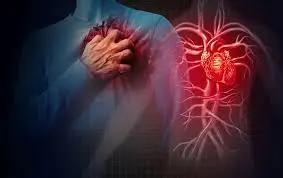Unstable angina is a serious warning sign that a heart attack may happen soon. It occurs when the heart muscle doesn’t receive enough oxygen-rich blood, often due to a blockage or narrowing in the coronary arteries. Unlike stable angina, which is predictable and manageable, unstable angina can strike without warning, putting individuals at a high risk of experiencing a devastating heart attack.
Recognising the signs and symptoms of unstable angina, understanding the underlying causes, and receiving prompt treatment are important for the prevention of life-threatening complications. In this article, we’ll explore the intricacies of unstable angina and look at the various treatment options available.
Understanding unstable angina
Unstable angina is a form of acute coronary syndrome, a group of conditions that occur when the heart’s blood supply is suddenly and severely reduced or blocked. This can happen for various reasons, including the rupture of plaque buildup in the coronary arteries, the formation of blood clots, or even spasms in the arteries.
The key difference between stable and unstable angina is the unpredictable nature of the symptoms. Whereas stable angina typically occurs during physical exertion or emotional stress and can be relieved by rest or medication, unstable angina can strike without warning, even while at rest. This unpredictability is what makes unstable angina a medical emergency, as it significantly increases the risk of a heart attack.
Symptoms and causes of unstable angina
The main symptom of unstable angina is chest pain or discomfort, which can vary in intensity and duration. Individuals with unstable angina may experience:
- Tight, sharp, or crushing chest pain that may spread to the arm, jaw, or back
- Chest pain that occurs even at rest or with minimal physical activity
- Chest pain that does not subside with rest or medication
- Shortness of breath, sweating, nausea, and dizziness
These symptoms are often the result of a partial or complete blockage in one or more of the coronary arteries, which restricts the flow of oxygen-rich blood to the heart muscle. This can happen due to the buildup of plaque, the formation of blood clots, or even spasms in the arteries.
In addition to the direct impact on the heart, unstable angina can also increase the risk of other serious complications, such as heart failure, abnormal heart rhythms (arrhythmias), and even sudden cardiac arrest.
Diagnosing unstable angina
Diagnosing unstable angina typically involves a combination of taking a medical history, physical examination, and various diagnostic tests. Your healthcare provider will likely start by asking about your symptoms, medical history, and any risk factors you may have for heart disease, such as high blood pressure, high cholesterol, or a family history of heart problems.
Next, they will perform a physical examination, which may include checking your vital signs, listening to your heart and lungs, and palpating your pulse. This can help identify any underlying conditions or abnormalities that may be contributing to your symptoms.
To confirm the diagnosis of unstable angina, your healthcare provider may order one or more of the following tests:
- Electrocardiogram (ECG): This test measures the electrical activity of your heart and can help detect any changes or abnormalities that may indicate unstable angina or a heart attack
- Cardiac biomarkers: Blood tests that measure the levels of certain proteins, such as troponin and creatine kinase-MB (CK-MB), can indicate if there has been any damage to the heart muscle
- Stress test: This test involves monitoring your heart’s activity at the same time as you exercising on a treadmill or stationary bike, which can help identify any areas of the heart that are not receiving enough blood flow
- Coronary angiography: This invasive procedure uses a thin, flexible tube called a catheter to inject a contrast dye into the coronary arteries, allowing your healthcare provider to visualise any blockages or narrowing
By combining the results of these tests, your healthcare provider can make an accurate diagnosis of unstable angina and develop a personalised treatment plan to address your specific needs.
Treating unstable angina
The main goal in treating unstable angina is to stabilise the condition, prevent a heart attack, and reduce the risk of further complications. The treatment approach typically involves a combination of medications, procedures, and lifestyle modifications, tailored to the individual’s needs.
Medications
The initial treatment for unstable angina often involves the use of various medications, including:
- Antiplatelet agents: Drugs like aspirin and clopidogrel help prevent the formation of blood clots, which can further obstruct the coronary arteries
- Nitrates: Nitroglycerin and other nitrate medications work by dilating the blood vessels, improving blood flow to the heart and relieving chest pain
- Beta-blockers: These drugs help reduce the heart’s workload by slowing the heart rate and decreasing the force of the heart’s contractions
- Statins: Cholesterol-lowering medications can help stabilise and even reverse the buildup of plaque in the coronary arteries
- Calcium channel blockers: These drugs relax and widen the blood vessels, improving blood flow to the heart
- Anticoagulants: Blood-thinning medications, such as heparin or enoxaparin, may be administered to prevent the formation of additional blood clots.
Your healthcare provider will carefully consider your circumstances, medical history, and risk factors when prescribing the appropriate medications for your unstable angina treatment.
Procedures
In some cases, medical procedures may be necessary to address the underlying causes of unstable angina and improve blood flow to the heart. These procedures include:
- Percutaneous Coronary Intervention (PCI): Also known as angioplasty, this minimally invasive procedure involves using a balloon-tipped catheter to widen the blocked or narrowed coronary artery, often followed by the placement of a small mesh tube called a stent to keep the artery open
- Coronary Artery Bypass Grafting (CABG): This surgical procedure involves creating a new pathway for blood to flow around the blocked or narrowed coronary artery, using a blood vessel taken from another part of the body
- The choice between PCI and CABG will depend on the extent and location of the coronary artery blockages, as well as your overall health and medical history.
Lifestyle modifications
In addition to medications and procedures, making healthy lifestyle changes can also play a crucial role in managing unstable angina and reducing the risk of future complications. These lifestyle modifications may include:
- Quitting smoking: Smoking is a major risk factor for heart disease and can exacerbate the symptoms of unstable angina
- Adopting a heart-healthy diet: Eating a diet rich in fruits, vegetables, whole grains, and lean proteins can help lower cholesterol and blood pressure levels
- Engaging in regular physical activity: Moderate exercise, such as brisk walking, can improve heart health and reduce the risk of angina episodes
- Managing stress: Finding healthy ways to cope with stress, such as through meditation, yoga, or counselling, can help lower blood pressure and improve overall well-being
- Maintaining a healthy weight: Achieving and maintaining a healthy body weight can help reduce the strain on the heart and improve cardiovascular function
By combining medical treatments with lifestyle changes, individuals with unstable angina can effectively manage their condition, reduce the risk of heart attacks and other complications, and improve their overall quality of life.
Preventing future complications
Proactive prevention is key to reducing the risk of future complications for individuals with unstable angina. In addition to the lifestyle modifications mentioned earlier, your healthcare provider may recommend the following strategies:
- Ongoing medication management: Continued use of anti-platelet agents, statins, and other medications as prescribed, is essential to maintain heart health and prevent further episodes of unstable angina
- Cardiac rehabilitation: Participation in a supervised exercise program and educational sessions can help improve cardiovascular fitness, manage risk factors, and reduce the risk of future cardiac events
- Regular monitoring and screening: Periodic check-ups, including stress tests and other diagnostic procedures, can help detect any changes in your condition and allow for early intervention if necessary
- Prompt treatment of any new symptoms: If you experience any new or worsening chest pain, shortness of breath, or other concerning symptoms, it’s crucial to seek immediate medical attention to prevent a potential heart attack
By taking an active role in your healthcare and working closely with your healthcare team, you can significantly improve your chances of preventing future complications and maintaining a healthy, active lifestyle.
Conclusion
Unstable angina is a serious and potentially life-threatening condition that requires prompt medical attention and treatment. Unstable angina outcomes can be improved through a combination of medical treatment, lifestyle modifications, and ongoing monitoring and follow-up care. By working closely with their healthcare providers and taking an active role in their health, many people with unstable angina can successfully manage their condition and reduce the risk of future cardiac events.
Sources
- Unstable Angina: Symptoms & Treatment
- Unstable Angina | American Heart Association
- Angina treatment: Stents, drugs, lifestyle changes — What’s best? – Mayo Clinic
- Angina – Treatment – NHS
Medical Disclaimer
NowPatient has taken all reasonable steps to ensure that all material is factually accurate, complete, and current. However, the knowledge and experience of a qualified healthcare professional should always be sought after instead of using the information on this page. Before taking any drug, you should always speak to your doctor or another qualified healthcare provider.
The information provided here about medications is subject to change and is not meant to include all uses, precautions, warnings, directions, drug interactions, allergic reactions, or negative effects. The absence of warnings or other information for a particular medication does not imply that the medication or medication combination is appropriate for all patients or for all possible purposes.








